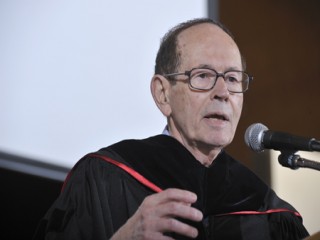
Gerald M. Edelman biography
Date of birth : 1929-07-01
Date of death : -
Birthplace : New York City,U.S.
Nationality : American
Category : Science and Technology
Last modified : 2011-12-21
Credited as : Biologist, Chemical structure of antibodies, Nobel laureate
0 votes so far
In interviews, he has said that the way the components of the immune system evolve over the life of the individual is analogous to the way the components of the brain evolve in a lifetime. There is a continuity in this way between his work on the immune system, for which he won the Nobel Prize, and his later work in neuroscience and in philosophy of mind.
After his Nobel prize award, Edelman began research into the regulation of primary cellular processes, particularly the control of cell growth and the development in multi-celled organisms, focussing on cell-to-cell interactions in early embryonic development and in the formation and function of the nervous system. These studies led to the discovery of cell adhesion molecules (CAMs), which guide the fundamental processes that help an animal achieve its shape and form, and by which nervous systems are built. One of the most significant discoveries made in this research is that the precursor gene for the neural cell adhesion molecule gave rise in evolution to the entire molecular system of adaptive immunity.
Edelman is the founder and director of The Neurosciences Institute, a nonprofit research center in San Diego that studies the biological bases of higher brain function in humans, and is on the scientific board of the World Knowledge Dialogue project
Edelman is a member of the USA Science and Engineering Festival's Advisory Board.
While in Paris serving in the Army, Edelman read a book that sparked his interest in antibodies.He decided that, since the book said so little about antibodies, he would investigate them further upon returning to the United States, which led him to study physical chemistry for his 1960 Ph.D. Research by Edelman and his colleagues and Rodney Robert Porter in the early 1960s produced fundamental breakthroughs in the understanding of the antibody's chemical structure, opening a door for further study. For this work, Edelman and Porter shared the Nobel Prize in Physiology or Medicine in 1972.
Edelman's early research on the structure of antibody proteins revealed that disulphide bonds link together the protein subunits. The protein subunits of antibodies are of two types, the larger heavy chains and the smaller light chains. Two light and two heavy chains are linked together by disulphide bonds to form a functional antibody.
Using experimental data from his own research and the work of others, Edelman developed molecular models of antibody proteins. A key feature of these models included the idea that the antigen binding domains of antibodies (Fab) include amino acids from both the light and heavy protein subunits. The inter-chain disulphide bonds help bring together the two parts of the antigen binding domain.
Edelman and his colleagues used cyanogen bromide and proteasees to fragment the antibody protein subunits into smaller pieces that could be analyzed for determination of their amino acid sequence. At the time when the first complete antibody sequence was determined (1969) it was the largest complete protein sequence that had ever been determined. The availability of amino acid sequences of antibody proteins allowed recognition of the fact that the body can produce many different antibody protein with similar antibody constant regions and divergent antibody variable regions.
Topobiology is an Edelman’s theory which asserts that morphogenesis is driven by differential adhesive interactions among heterogeneous cell populations and it explains how a single cell can give rise to a complex multi-cellular organism. As proposed by Edelman in 1988 topobiology is the process that sculpts and maintains differentiated tissues and is acquired by the energetically favored segregation of cells through heterologous cellular interactions.
Edelman and Gally were the first to point out the pervasiveness of Degeneracy in biological systems and the fundamental role that degeneracy plays in facilitating evolution.
















